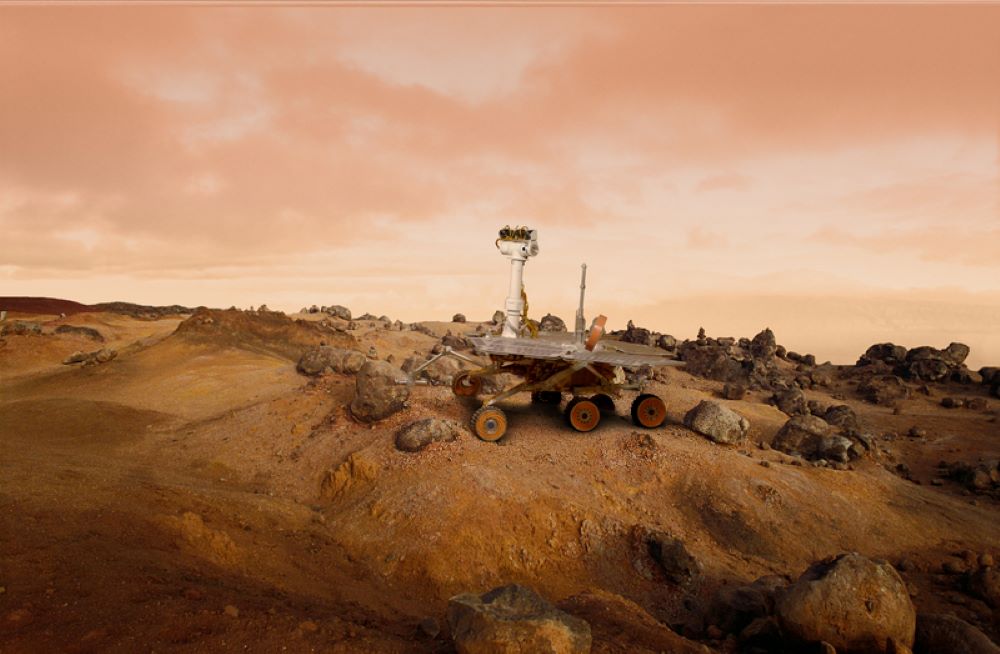 Mars is the target for many exploration missions.A photograph taken from space of Mars. It shows the full globe of the planet, coloured bright orange and brown, surrounded by the black background of space. Across the middle of the globe runs a dark brown feature, which looks like a scar but is a deep valley.Since the 1960s, Mars has been a
primary target for numerous missions, with flybys, orbiting spacecraft, static
landers and rovers all providing us with a wealth of new
information about the red planet. One of the key objectives of many of these,
and future, missions is to understand more about the martian environment today
and throughout its geological history. This has revealed substantial evidence
that at periods
in Mars’ history there was liquid water and potentially even environments that
might have been habitable to life. It has also shown that, although Mars today
is dry and hostile, some water does still exist on the planet.
Mars is the target for many exploration missions.A photograph taken from space of Mars. It shows the full globe of the planet, coloured bright orange and brown, surrounded by the black background of space. Across the middle of the globe runs a dark brown feature, which looks like a scar but is a deep valley.Since the 1960s, Mars has been a
primary target for numerous missions, with flybys, orbiting spacecraft, static
landers and rovers all providing us with a wealth of new
information about the red planet. One of the key objectives of many of these,
and future, missions is to understand more about the martian environment today
and throughout its geological history. This has revealed substantial evidence
that at periods
in Mars’ history there was liquid water and potentially even environments that
might have been habitable to life. It has also shown that, although Mars today
is dry and hostile, some water does still exist on the planet.
Planetary
Protection
Finding evidence of life is one of the key objectives driving the scientific investigations of many of the current and future missions to Mars. However, it’s imperative that any evidence found is not complicated by the presence of contamination that might have been carried by a spacecraft from Earth.
Planetary Protection is the practice of protecting Solar System bodies from contamination by Earth life and protecting Earth from possible life forms that may be returned from other Solar System bodies. Approaches to this taken by space agencies and mission teams have changed over the 60 years of Mars exploration and will continue to adapt to new scientific understanding of the planet and of life itself. However, the central principle is to minimise the amount of biological material (bioburden) carried by a spacecraft that might contaminate the martian surface.
Setting standards
It was required that the Viking landers that reached Mars in 1976 carried with them 300 terrestrial bacterial spores per m2 (spores are used as a proxy for all microbial contamination as they are highly resistant to environmental extremes) with the risk of contamination being 1 x 10-3. Even at that time, monitoring of the spacecrafts’ bioburden and sterilisation procedures was central to their design and build; the landers were cleaned, and then dry heat sterilised for 30 hours at temperatures above 120 °C to reduce contamination. This was critical because the landers carried a gas chromatography-mass spectrometer (GCMS) intended to look for organic matter that might be indicative of life.
 The Viking lander being prepared for sterilisation procedures as part of the mission’s Planetary Protection procedures (then called ‘planetary quarantine’).A photograph of the Viking spacecraft with a roughly hemispherical shape. It is white and approximately 3 metres in diameter. It is positioned on a raised stage within a square room that appears to have metallic walls. Five people are looking at the spacecraft and they are dressed in all-in-one white cleanroom suits with hoods and overshoes.
The Viking lander being prepared for sterilisation procedures as part of the mission’s Planetary Protection procedures (then called ‘planetary quarantine’).A photograph of the Viking spacecraft with a roughly hemispherical shape. It is white and approximately 3 metres in diameter. It is positioned on a raised stage within a square room that appears to have metallic walls. Five people are looking at the spacecraft and they are dressed in all-in-one white cleanroom suits with hoods and overshoes.
Today, Mars missions are categorised depending on the type of mission
(whether it is a flyby, orbiter or lander) as part of the Policy on Planetary Protection, which also outlines the bioburden it can
carry. Orbiting spacecraft, such as ExoMars Trace Gas Orbiter, are Category III (the lowest category of mission is Category I),
requiring less than 5 x 105 bacteria spores be carried by the
spacecraft. Although these types of
missions are not planned to land on the planet’s surface, there is still a
possibility that it might touch down either through mission failure or at
mission end and so Planetary Protection considerations are still
important.
Landers are Category IV. These have the greatest risk of contaminating the martian surface because they could deliver terrestrial contamination directly to the planet’s surface, but the Planetary Protection requirements depend on the mission objectives. Those lander missions not designed to look for evidence of life (Category IVa) must carry fewer than 3 x 105 bacterial spores, whereas those that are designed to look for life (Category IVc) are restricted to fewer than 30 spores.
All spacecraft in these categories must be built within an environmentally monitored cleanroom and undergo stringent monitoring and cleaning procedures before launch. For example, the Beagle 2 Mars lander, which was carried by ESA’s Mars Express mission, was assembled within the Aseptic Assembly Facility, a high-specification cleanroom on the Open University’s campus in Milton Keynes.
 Assembly of the Beagle 2 Mars lander in the Aseptic Assembly Facility at the Open University in Milton Keynes. Beagle 2 landed on Mars in 2003 but did not communicate with Earth and was presumed lost until identified on images taken from orbit in 2014.A photograph showing a gold, approximately 1 metre diameter spacecraft in the centre of a relatively empty room. Four people dressed in blue all-in-one suits, hoods, masks, goggles and gloves are looking at the spacecraft.
Assembly of the Beagle 2 Mars lander in the Aseptic Assembly Facility at the Open University in Milton Keynes. Beagle 2 landed on Mars in 2003 but did not communicate with Earth and was presumed lost until identified on images taken from orbit in 2014.A photograph showing a gold, approximately 1 metre diameter spacecraft in the centre of a relatively empty room. Four people dressed in blue all-in-one suits, hoods, masks, goggles and gloves are looking at the spacecraft.
Special Regions on Mars
Category IVc missions are a special case because they are likely to visit Special Regions on Mars. These have been defined as areas where terrestrial organisms carried by a spacecraft might be able to survive and thrive, or where there is high potential for living martian organisms to be found. The temperature must be greater than -28°C and have a water activity of 0.5 (see below). This currently includes gullies, cavities, and the surface features known as Recurrent Slope Lineae, but could include any areas that show evidence of groundwater, methane (a potential gas emitted by life) or geothermal energy.
Water activity is a measurement of the availability of water to biological processes. It depends on the presence of solutes and the relative humidity of the environment. The higher the concentration of solutes in a water, the lower the water activity. The lower the water activity, the less likely the environment is to host life.
 Recurring Slope Lineae appearing as dark streaks on the walls of Garni Crater on Mars.A black and white photograph taken from orbit of the inside wall of an impact crater. The horizon beyond the crater is dark grey and the background is space coloured black. The crater wall has many black vertical steaks.
Recurring Slope Lineae appearing as dark streaks on the walls of Garni Crater on Mars.A black and white photograph taken from orbit of the inside wall of an impact crater. The horizon beyond the crater is dark grey and the background is space coloured black. The crater wall has many black vertical steaks.
Mars sample return
While most of the focus around Planetary Protection has been on the risks to Mars from terrestrial contamination, missions that might return to Earth from Mars carrying martian materials are already planned. Samples of rocks and soils are being collected by NASA’s Perseverance rover (currently on Mars), stored there, and will be returned to Earth by a future mission, sometime in the 2030s. A sample return mission from Mars would be categorised as Category V ‘Restricted Earth return’.
To prepare for this eventuality, much effort has been put into understanding the harsh martian environment and its potential effect on life and its proliferation. In addition, to reduce the risk to Earth’s biosphere, the samples brought back to Earth would be stored, curated and analysed in special facilities preventing any material from entering the outside world until it was proven to be safe.
The future of Mars exploration
The near-future reality is of human exploration of Mars, and some of these missions (and indeed future robotic missions) may be led by non-governmental organisations. These missions may also choose to land close to sites where water is available for life support or fuel. This all presents a further challenge for Planetary Protection, with a need to maintain Mars as an unspoilt and uncontaminated environment and ensure the health of those humans who visit the planet.
 This article is part of the Astrobiology Collection on OpenLearn. This collection of free articles, interactives, videos and courses provides insights into research that investigates the possibilities of life beyond the Earth and the ethical and governance implications of this.
This article is part of the Astrobiology Collection on OpenLearn. This collection of free articles, interactives, videos and courses provides insights into research that investigates the possibilities of life beyond the Earth and the ethical and governance implications of this.




Rate and Review
Rate this article
Review this article
Log into OpenLearn to leave reviews and join in the conversation.
Article reviews